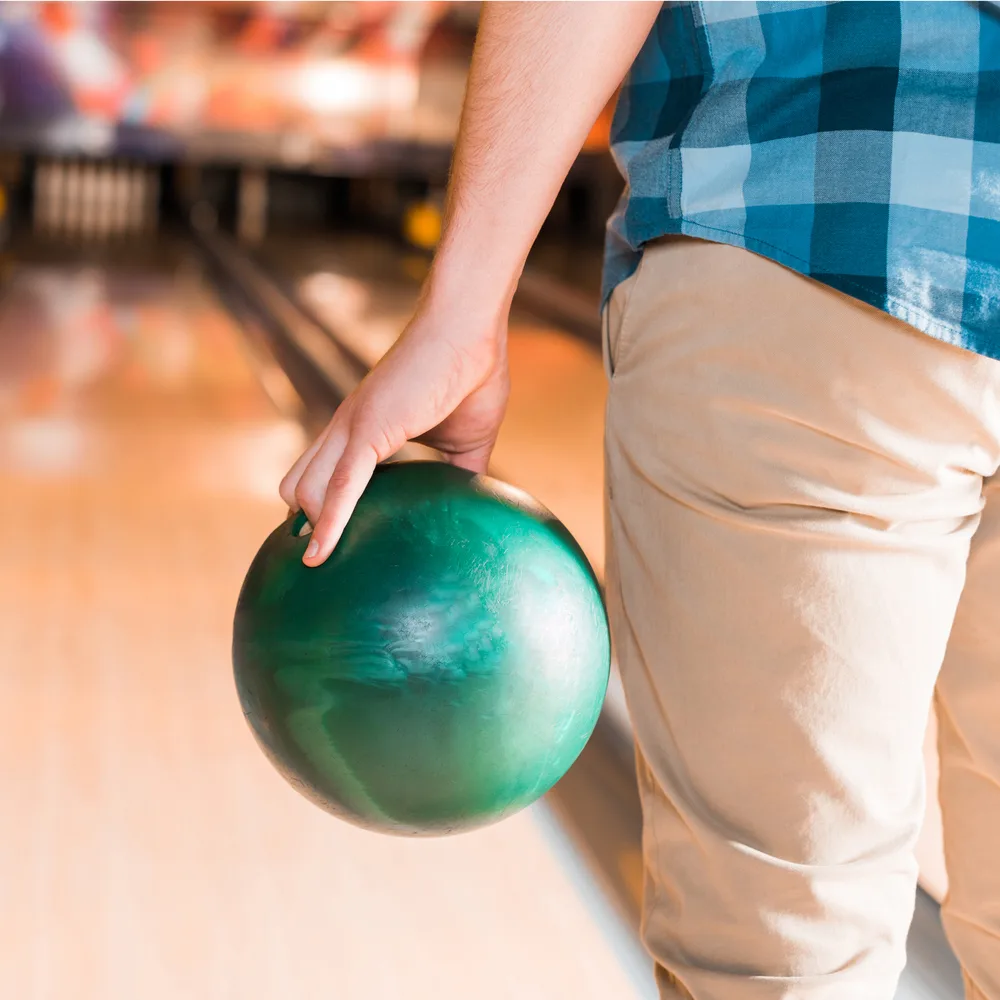
Bowlers typically throw the ten pin bowling ball underhand; it’s rare to see anyone throw it any other way. But what happens if you do the opposite and try it overhand?
That’s precisely what you’re going to find out. By the end of this article, you’ll know what overhand bowling is and how it could affect your game.
Let’s get right into it!
Contents
What is Overhand Bowling?
Overhand bowling is simply when the bowler throws the bowling ball over their shoulder instead of releasing it from underneath. This throw is common in softball or baseball, but it’s almost never seen in bowling.
Overhand bowling has an element of quirkiness—it looks different from the norm and can be challenging to execute well.
Key Takeaways
- Overhand Bowling: A technique where the bowler throws the ball over their shoulder, similar to baseball pitches. Rare in bowling and considered quirky due to its uncommon execution and challenges in control.
- Lane Damage and Etiquette: Overhand throws can harm bowling lanes, especially wooden ones, and are seen as bad etiquette. Such actions may lead to fines or expulsion from bowling alleys due to potential damage and the risk of injury to others.
- Underhand Bowling Benefits: Underhand bowling is preferred for its control, allowing for straighter rolls and better spin. It aligns with standard bowling practices, offering a higher chance of strikes and adhering to the game’s traditional playing style.
- Scoring and Skill Development: Overhand bowling drastically reduces scoring potential with sporadic strikes. Sticking to underhand bowling is advised for skill improvement and consistent scoring.
- Bowling Etiquette and Practice Tips: Emphasizes waiting for others before bowling, avoiding unsolicited advice, handling equipment carefully, and cleaning up. For better underhand technique, choose the right ball weight, focus on a straight release, and practice regularly to refine skills.
Overhand Bowling Is Frowned Upon
Overhand bowling is generally frowned upon for several reasons. For one, it can damage the bowling lanes. The standard bowling lane is built to withstand underhand throws; anything else can cause problems, especially on wooden lanes.
The more modern synthetic lanes were designed to last longer and are more durable.
In addition, throwing the ball overhand will likely result in a gutterball because you don’t have much control over trajectory. Your ball has a better chance of staying on the lane if you throw it underhand.

Is Overhand Bowling Bad Bowling Etiquette?
Overhand bowling is not only a bad idea for any individual bowler, but it’s also considered lousy bowling etiquette. If you bowl overhand, be prepared for some dirty looks from other bowlers.
In addition, you may be asked to leave the bowling alley if management catches you bowling overhand. And that’s a good thing since overhand bowling could result in you racking up some hefty fines should you damage something, injure yourself, or hurt someone else.
Reasons Underhand Bowling Is Better Than Overhand Bowling
Now that we’ve looked at why you shouldn’t bowl overhand, let’s take a quick look at more reasons you should stick to underhand bowling.
For one, it’s much easier to control and roll a straight ball when your ball when thrown underhand. You can reliably spin the ball and maintain greater control over trajectory, resulting in a better chance of getting a strike.
In addition, underhand bowling is the most widely accepted way to bowl. When you bowl overhand, you’re not playing the ten pin game of bowling as it’s designed to be played. You’re just throwing a heavy bowling ball down a lane and hoping for the best.

Overhand Strikes are Rare
Overhand bowling is really bad for your scoring potential. That’s why it’s very rare to see someone get a strike when bowling overhand.
So, if your goal is to get strikes (and we bet it is), you should go with a throwing technique geared toward that.
Therefore, we encourage you to stick with underhand bowling. It’s the best way to hone your skills on the lanes.
Want to Overhand Bowl Anyway?
Do you still have the urge to bowl overhand? If that’s the case, you can do it, but you should do it on your own property. That way, if you break something, you won’t have to worry about getting in trouble or paying for damages.
Just get your hands on a home bowling alley set or build your own alley from scratch. Then you can overhand bowl in the safety of your home!
| Comparison | Overhand Bowling | Underhand Bowling |
|---|---|---|
| Technique | Thrown over the shoulder | Released from underneath |
| Lane Impact | Can cause more damage, especially to wooden lanes | Minimally impacts lanes |
| Control | Difficult to control trajectory, increasing gutterball likelihood | Easier to control, allowing for straighter rolls and spins |
| Etiquette | Generally frowned upon, can lead to expulsion from alleys | Widely accepted and adheres to traditional bowling etiquette |
| Scoring Potential | Low, strikes are rare | Higher, improves chance of strikes and spares |
Bowling Etiquette Tips to Keep in Mind
Bowling etiquette is a set of unwritten rules that bowlers abide by when playing together in a public place. Bowling underhand is one of such rules, but it isn’t the only one.
There are a few other rules to keep in mind to maintain good etiquette, and we’ll go through them below.
- Give other bowlers near you a chance to roll uninterrupted. This means waiting until your lane-mates have thrown their balls before you step up to the line.
- Don’t be a backseat bowler. Refrain from giving others bowling tips when they haven’t asked for them. No one wants to be bossed around while trying to enjoy the game.
- Be careful when you’re handling the bowling balls. These balls are an expense for the bowling alley and can damage the lane or accompanying equipment if you’re not careful.
- Wipe up any spills immediately. This will help to keep the lanes clean and dry so that others can bowl without slipping.
- Be respectful of other bowlers. Don’t make too much noise, and try not to get in anyone’s way. Some bowlers need to have total concentration in order to get a strike, and you don’t want to be the one who disrupts that. Also, if you pick a fight with someone, you both could be asked to leave the bowling alley.
- Don’t take the bowling alley’s balls. This should be obvious, but unfortunately, it happens more often than you might think. Your rental shoes should stay at the bowling alley as well.
- Don’t make a spectacle of yourself. You can dance around and celebrate every time you get a strike or when they play your song. But dancing on top of the tables is always a no-no.
- Be sure to clean up after yourself and throw away all trash in your lane before you exit the bowling alley. It’s common courtesy and will make life a bit easier for the bowling alley staff.

Quick Underhand Bowling Tips
If you’re new to bowling, you might wonder how to master the underhand technique. Contrary to what you might think, it’s easy and more accurate once you get the hang of it!
Here are a few tips to help you get started.
- Choose the right ball. You’ll want to pick a ball that’s not too heavy and not too light. A good rule of thumb for ball weight is to choose one that’s 10% of your body weight. Though, the perfect weight will depend on your strength and bowling style. If you’re a beginner, opt for a straight ball made of plastic. It’s ideal for anyone who wants their ball to go straight down the lane. When you get more experience under your belt, branch out and try different types of balls. Urethane and reactive resin balls are ideal for avid and professional bowlers.
- Start by positioning yourself at the center of the lane. You’ll want to be sure that your feet are shoulder-width apart and that your weight is evenly distributed. Take a few steps toward the lane and stop when your front foot is a few inches away from the foul line.
- As you approach the lane, swing the ball backward and then forward. Extend your arm as far as is comfortable for you.
- Straight release the ball when it’s at about eye level. As you release the ball, your hand should be palm-up. Be sure to follow through with your hand and arm, so your ball rolls off your fingers in the direction you’re aiming.
- Practice a ton! The only way to improve at bowling is to get out on the lanes and refine your skills. So, find a friend or family member who’s game and head to the nearest bowling alley. And even if you don’t have someone to accompany you, don’t be afraid to go solo. Bowling alone not only gives you a chance to improve your skills uninterrupted, but it can also be a fun and relaxing way to kill some free time.

Related Articles
Embracing the traditional underhand bowling technique minimizes the risk of lane damage and positions players to excel in league games and increase their scores by hitting more pins. From the stance and slide to the moment the ball is released and rolls down the lane, every action is crucial in determining the angle and momentum of the shot, targeting the arrows on the floor for precision. It’s important to note, especially for beginners and kids, that mastering this technique can save money on repairs and avoid pressure from bowling etiquette norms.
Imagine the satisfaction of consistently rolling strikes or picking up spares with ease. Of course, for those curious about overhand bowling, YouTube provides a safe, virtual space to explore this unconventional method without the deal of actual lane damage or breaking any unwritten rules of the bowling community.
Kira Byrd, a Certified Fraud Examiner, holds a B.S. in Accounting from the University of Alabama at Birmingham. With a passion for bowling from her childhood, Kira has poured her expertise and personal experiences into creating and nurturing Bowling For Beginners. Kira’s mission is to meet new bowlers where they are and guide them toward consistently achieving higher scores. With a focus on skill development and strategic techniques, she empowers readers to take control of their game and unlock their true potential.
Bowling For Beginners embodies strict editorial integrity, ensuring reliable and unbiased information. Kira’s commitment to delivering valuable insights and practical strategies is reflected in every article. Here’s an explanation of our editorial policy and how we get money.

